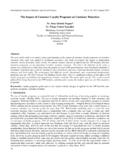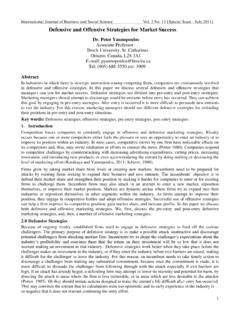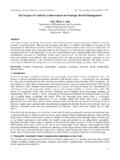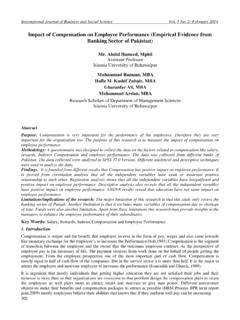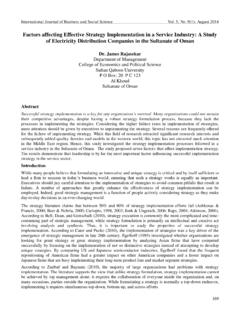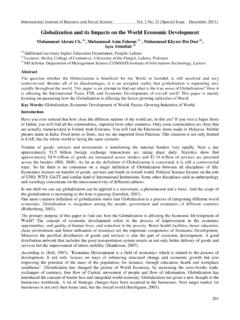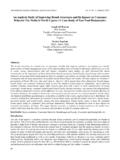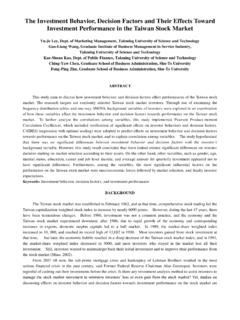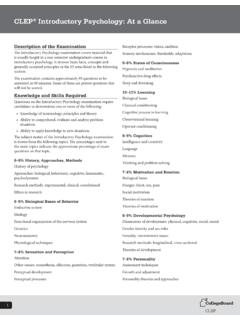Transcription of Performance Appraisal: A Supervision or Leadership …
1 International Journal of Business and Social Science Vol. 2 No. 17 29 Performance Appraisal: A Supervision or Leadership Tool? Rosa Cintr n, (Corresponding author) University of Central Florida, USA 1000 Foxfire Trail, Oviedo, FL 32765 E-mail: Phone: 407-823-1248 Forrest Flaniken, University of Central Florida, USA 1000 Foxfire Trail, Oviedo, FL 32765 E-mail: Phone: 407-207-6745 Abstract Although there is substantial literature on the use of Performance appraisal in the for-profit sector, there is little literature available concerning the appraisal of staff positions in American higher education.
2 This study provides a detailed look in a population of 108 colleges and universities. Dissatisfaction was found with the appraisal process due to (a) lack of Leadership support, (b) supervisors not being held accountable for the timely completion of appraisals, and (c) the lack of training provided supervisors for doing Performance appraisals well. Key Words: Performance appraisal, higher education, staff, Supervision , Leadership Introduction Performance appraisal is an unavoidable element of organizational life (Brown, 1988; Longenecker & Fink, 1999).
3 There are many decisions in modern organizations that depend on Performance appraisals, and they are widely used in most organizations (Burkhalter & Buford, 1989; Davis, 2001; DeNisi, 1996; Wanguri, 1995). They are an important piece of the process by which organizations attempt to direct themselves (Kreitner, 1998; Landy & Farr, 1983), and they have been considered a key component in the success of organizations for most of the twentieth century (Grote, 2002; Pettijohn, Parker, Pettijohn, & Kent, 2001; Rasch, 2004; Starcher, 1996).
4 Performance appraisal allows organizations to inform their employees about their rates of growth, their competencies, and their potentials. It enables employees to be intentional in creating their individual developmental goals to help in their personal growth. There is little disagreement that if Performance appraisal is done well, it serves a very useful role in reconciling the needs of the individual and the needs of the organization (Cleveland, Landy, & Zedeck, 1983; Conry & Kemper, 1993; Grote, 1996).
5 If used well, Performance appraisal is an influential tool that organizations have to organize and coordinate the power of every employee of the organization towards the achievement of its strategic goals (Grote, 2002; Lewis, 1996). It can focus each employee s mind on the organization s mission, vision, and core values. However, if Performance appraisal is not done well, Grote suggests the process can become the object of jokes and the target of ridicule. Literature Review Performance evaluation methods are the systems and processes through which appraisal is carried out in an organization.
6 The methods include determining the types of data collected and evaluated in the appraisal, the forms and frequencies of communication that take place between supervisors and their employees, and the various types of evaluation tools used to measure Performance . It is important to understand the evaluation methods used because they can influence the usefulness of the appraisal system in an organization and the perceived or actual benefits gained from its use. Performance evaluation methods have been described by multiple authors in various ways.
7 Landy and Farr (1983) define a method in which the Performance appraisal data is organized into two groups: judgmental or subjective measures and nonjudgmental or objective measures. Although judgmental measures are more broadly used, objective Performance measurements ( production rates, time to complete a task, and scrap rates) have been helpful measures of Performance for routine, manual jobs since the 1940s (Rothe, 1946). Other non-judgmental indices that do not assess Performance directly but provide information on the general health of the organization, including absenteeism, turnover, and accidents, have also been researched (Campbell, Ford, Rumsey, Pulakos, Borman & Felker 1990).
8 Objective measures do have their unique problems, however. The Special Issue on Contemporary Issues in Business Studies Centre for Promoting Ideas, USA 30 For example, absentee measures are not applicable to many jobs, are often inaccurate, are caused by a variety of reasons depending on the meaning of absence, differ in the duration of observation, and do not show a relationship with each other (Murphy & Cleveland, 1995). Using turnover as a standard is complicated because it is hard to differentiate between voluntary and compulsory turnover.
9 Grievances are not typically obtainable for nonunion employees. Accidents could be caused by the people or by their environments. The rate of promotion or salary increases are not good standards because the rate could be controlled by a quota set by the organization and salary modifications could be influenced by the economic well-being of the organization rather than employee Performance . These problems challenge the validity of the measures (Murphy & Cleveland, 1995). Landy and Farr (1983) also identified several problems with objective measures and potential reasons why judgmental measures have been used instead by psychologists for evaluating managerial behavior.
10 First, objective measures tend to have low reliability. For example, factors external to the individual, such as the organization s sick leave policies, may influence the reliability of absence measures or the period of inspection may not be constant across measures. Another reason is that objective measures may be obtainable for only a partial number of jobs. For example, it does not make sense to collect information on tardiness or absences from sales representatives or development employees who may not work a fixed number of hours per day or per week.
